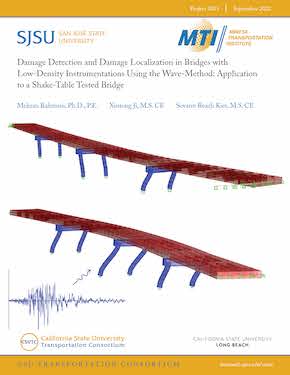- 408-924-7560
- mineta-institute@sjsu.edu
- Donate
Damage Detection and Damage Localization in Bridges with Low-Density Instrumentations Using the Wave-Method: Application to a Shake-Table Tested Bridge
This study presents a major development to the wave method, a methodology used for structural identification and monitoring. The research team tested the method for use in structural damage detection and damage localization in bridges, the latter being a challenging task. The main goal was to assess capability of the improved method by applying it to a shake-table-tested prototype bridge with sparse instrumentation. The bridge was a 4-span reinforced concrete structure comprising two columns at each bent (6 columns total) and a flat slab. It was tested to failure using seven biaxial excitations at its base. Availability of a robust and verified method, which can work with sparse recording stations, can be valuable for detecting damage in bridges soon after an earthquake. The proposed method in this study includes estimating the shear (cS) and the longitudinal (cL) wave velocities by fitting an equivalent uniform Timoshenko beam model in impulse response functions of the recorded acceleration response. The identification algorithm is enhanced by adding the model’s damping ratio to the unknown parameters, as well as performing the identification for a range of initial values to avoid early convergence to a local minimum. Finally, the research team detect damage in the bridge columns by monitoring trends in the identified shear wave velocities from one damaging event to another. A comprehensive comparison between the reductions in shear wave velocities and the actual observed damages in the bridge columns is presented. The results revealed that the reduction of cS is generally consistent with the observed distribution and severity of damage during each biaxial motion. At bents 1 and 3, cS is consistently reduced with the progression of damage. The trends correctly detected the onset of damage at bent 1 during biaxial 3, and damage in bent 3 during biaxial 4. The most significant reduction was caused by the last two biaxial motions in bents 1 and 3, also consistent with the surveyed damage. In bent 2 (middle bent), the reduction trend in cS was relatively minor, correctly showing minor damage at this bent. Based on these findings, the team concluded that the enhanced wave method presented in this study was capable of detecting damage in the bridge and identifying the location of the most severe damage. The proposed methodology is a fast and inexpensive tool for real-time or near real-time damage detection and localization in similar bridges, especially those with sparsely deployed accelerometers.
MEHRAN RAHMANI, PHD, PE
Dr. Rahmani is an Assistant Professor in the Civil Engineering and Construction Management Department of California State University Long Beach (CSULB). He earned a Ph.D. in Structural and Earthquake Engineering from the University of Southern California (USC) in 2014, an MS in Electrical Engineering (with an emphasis in Signal Processing) from USC in 2013, and an MS in Structural Engineering from Sharif University of Technology (Iran) in 2009. Prior to joining CSULB, Dr. Rahmani, a registered Professional Engineer (P.E.) in California, worked as a Senior Engineer and Project Engineer for the structural engineering industry from 2014 to 2017. Dr. Rahmani’s research focuses on structural system identification, structural health monitoring, and earthquake damage detection of buildings and bridges using sensory data. His Ph.D. research focused on developing a wave-based methodology for remote post-earthquake structural damage detection that is robust when applied to actual structures and is calibrated using data from full-scale buildings and was funded by NSF (CMMI-0800399). He has been instrumental in the advances in wave-based structural identification and monitoring in the past 15 years, receiving more than 450 citations for his technical papers.
XINTONG JI, MS CE
Xintong received her BS in Civil Engineering from California State University, Long Beach and graduated in Summer 2020 with her Master’s in Structural Engineering.
SOVANN REACH KIET, MS CE
Sovann graduated in Spring 2021 with his Master’s in Structural Engineering from California State University, Long Beach.
-
Contact Us
San José State University One Washington Square, San Jose, CA 95192 Phone: 408-924-7560 Email: mineta-institute@sjsu.edu






